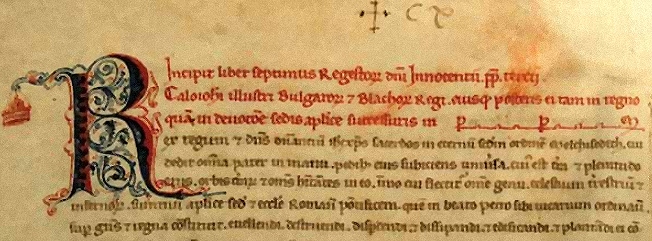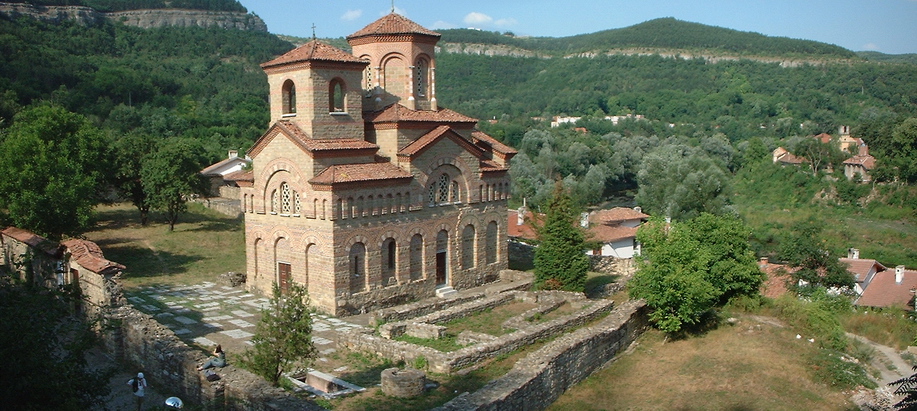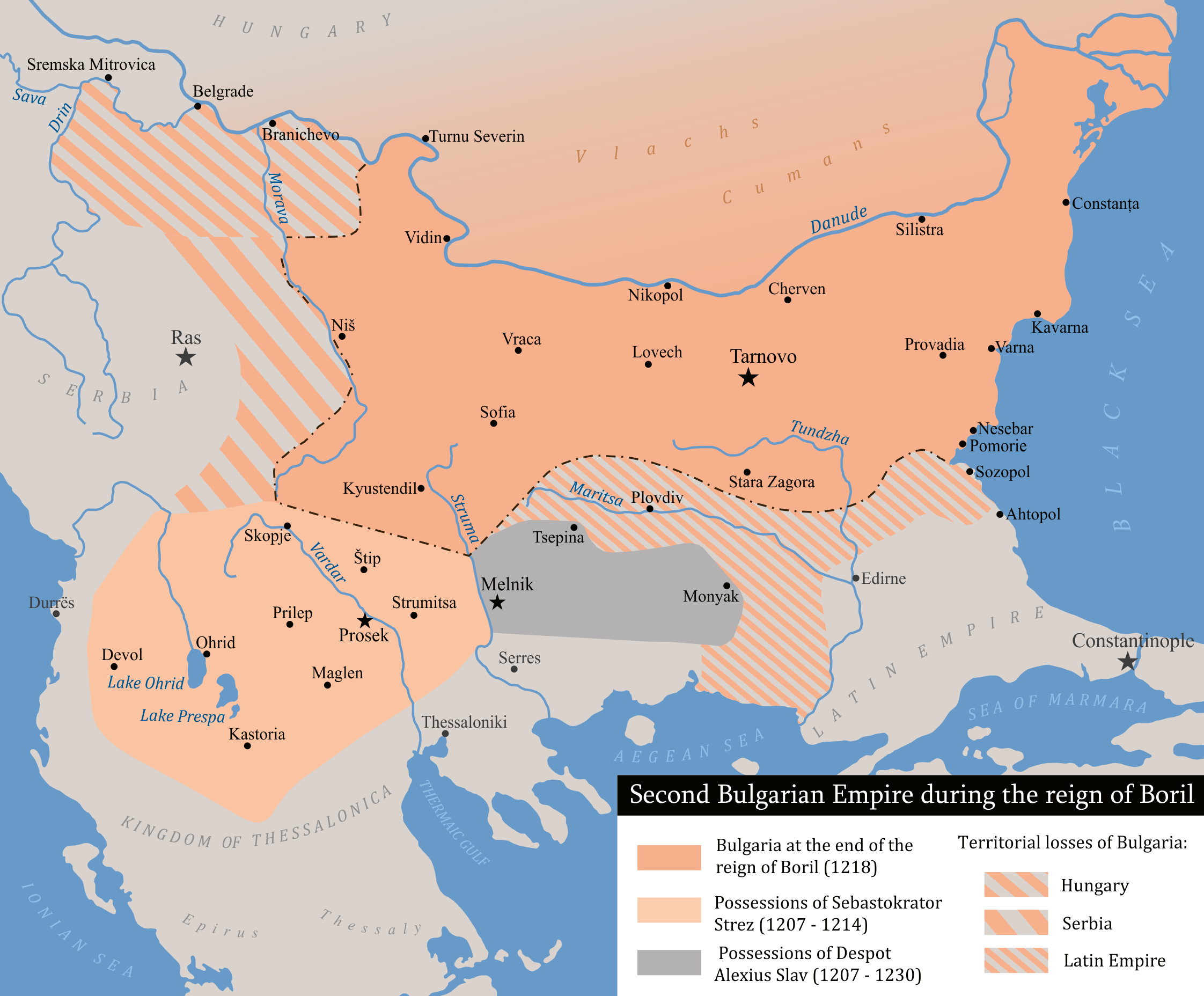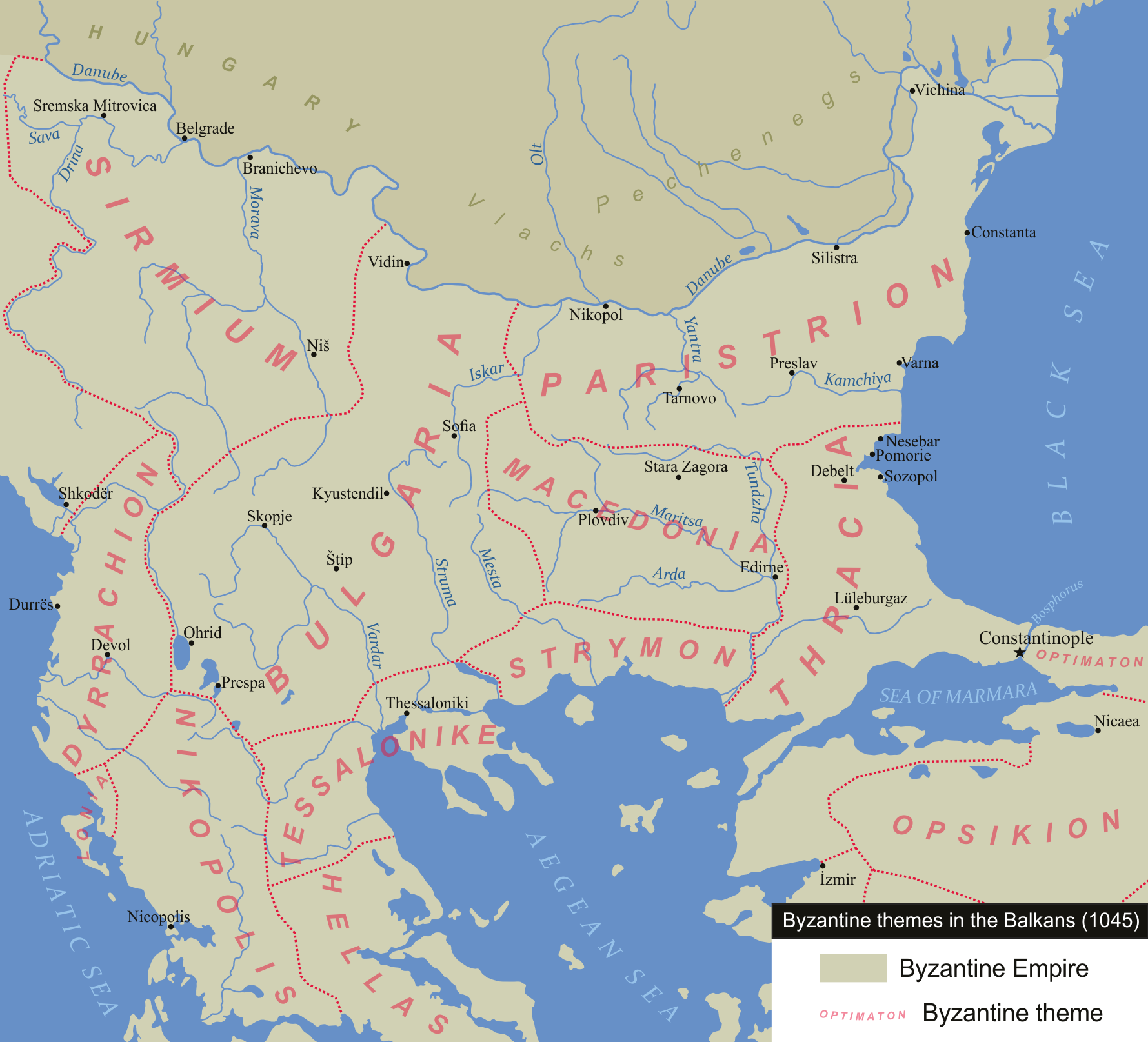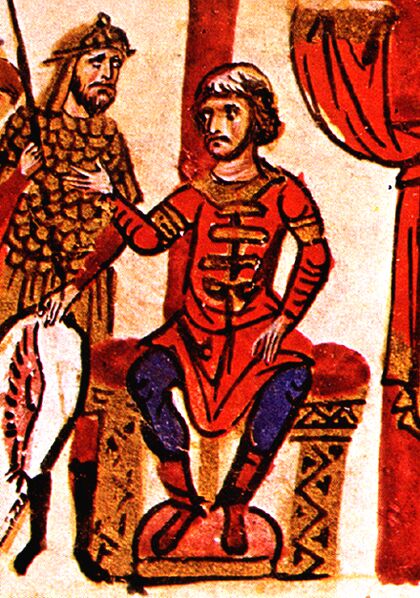|
Kaloyan
Kaloyan or Kalojan, also known as Ioannitsa or Johannitsa ( bg, Калоян, Йоаница; 1170 – October 1207), was emperor or tsar of Bulgaria from 1196 to 1207. He was the younger brother of Theodor and Asen, who led the anti-Byzantine uprising of the Bulgarians and Vlachs in 1185. The uprising ended with the restoration of Bulgaria as an independent state. He spent a few years as a hostage in Constantinople in the late 1180s. Theodor, crowned Emperor Peter II, made him his co-ruler after Asen was murdered in 1196. A year later, Peter was also murdered, and Kaloyan became the sole ruler of Bulgaria. To obtain an imperial title from the Holy See, Kaloyan entered into correspondence with Pope Innocent III, offering to acknowledge papal primacy. His expansionist policy brought him into conflict with the Byzantine Empire, Hungary, and Serbia. In 1204, King Emeric of Hungary allowed the papal legate who was to deliver a royal crown to Kaloyan to enter Bulgaria only at the ... [...More Info...] [...Related Items...] OR: [Wikipedia] [Google] [Baidu] |
Second Bulgarian Empire
The Second Bulgarian Empire (; ) was a medieval Bulgarian state that existed between 1185 and 1396. A successor to the First Bulgarian Empire, it reached the peak of its power under Tsars Kaloyan and Ivan Asen II before gradually being conquered by the Ottomans in the late 14th century. Until 1256, the Second Bulgarian Empire was the dominant power in the Balkans, defeating the Byzantine Empire in several major battles. In 1205, Emperor Kaloyan defeated the newly established Latin Empire in the Battle of Adrianople. His nephew Ivan Asen II defeated the Despotate of Epiros and made Bulgaria a regional power again. During his reign, Bulgaria spread from the Adriatic to the Black Sea and the economy flourished. In the late 13th century, however, the Empire declined under constant invasions by Mongols, Byzantines, Hungarians, and Serbs, as well as internal unrest and revolts. The 14th century saw a temporary recovery and stability, but also the peak of Balkan feudalism as c ... [...More Info...] [...Related Items...] OR: [Wikipedia] [Google] [Baidu] |
Kumankata
The name of the Cuman noblewoman who subsequently married two Tsars Emperors of Bulgaria, Kaloyan of Bulgaria and Boril of Bulgaria, is unknown. There are only two sources mentioning her, both foreign. The Byzantine historian George Akropolites claimed that after the death of Kaloyan, his sister's son Boril 'married his Scythian aunt'. From this evidence, it is not sure whether the Tsaritsa was really a Cuman, or she belonged to another tribe that could be described as Scythian. As Veselin Ignatov points out, given the strong relations between the Asen dynasty and the Cumans, her Cuman lineage is the most probable possibility, but not the only one. She is known in Bulgarian historiography as ''Kumankata'' ( bg, Куманката, "the Cuman oman). The second source mentioning the Tsaritsa was made by Canon Alberih about 1241. He repeated a story that he had heard from a Flemish priest who claimed to have visited the Bulgarian capital of Tarnovo. The priest claimed that the Tsaritsa ... [...More Info...] [...Related Items...] OR: [Wikipedia] [Google] [Baidu] |
Peter II Of Bulgaria
Peter II,), because they take into consideration two previous leaders of anti-Byzantine rebellions, Peter Delyan (who assumed the imperial title in 1040) and Constantine Bodin (who took the name Peter in 1072)., group=note born Theodor, also known as Theodor-Peter ( bg, Теодор-Петър; died in 1197), was the first emperor or tsar of the restored Bulgarian Empire from 1185 to 1197. He hails from the Byzantine theme of Paristrion, although his exact place and date of birth are unknown. He and his younger brothers, Asen and Kaloyan, were mentioned as Vlachs in most foreign contemporaneous sources, but they were probably of a mixed Vlach, Bulgarian, and Cuman origin. In 1185, Theodor and Asen approached the Byzantine Emperor Isaac II Angelos in Thrace, demanding an estate in the Balkan Mountains. After the Emperor refused and humiliated them, they decided to incite a rebellion, taking advantage of the discontent that a new tax had caused among the Bulgarians and Vlachs. ... [...More Info...] [...Related Items...] OR: [Wikipedia] [Google] [Baidu] |
Boril Of Bulgaria
Boril ( bg, Борил) was the emperor (tsar) of Bulgaria from 1207 to 1218. He was the son of an unnamed sister of his predecessor, Kaloyan and Kaloyan's brothers, Peter II and Ivan Asen I, who had restored the independent Bulgarian state. After Kaloyan died unexpectedly in October 1207, Boril married his widow, a Cuman princess and seized the throne. His cousin, Ivan Asen, fled from Bulgaria, enabling Boril to strengthen his position. His other kinsmen, Strez and Alexius Slav, refused to acknowledge him as the lawful monarch. Strez took possession of the land between the Struma and Vardar rivers with the support of Stefan Nemanjić of Serbia. Alexius Slav secured his rule in the Rhodope Mountains with the assistance of Henry, the Latin Emperor of Constantinople. Boril launched unsuccessful military campaigns against the Latin Empire and the Kingdom of Thessalonica during the first years of his reign. He convoked the synod of the Bulgarian Church in ea ... [...More Info...] [...Related Items...] OR: [Wikipedia] [Google] [Baidu] |
Ivan Asen I Of Bulgaria
Ivan Asen I, also known as Asen I or John Asen I ( bg, Иван Асен I; died in 1196), was emperor or tsar of Bulgaria from 1187/1188 to 1196 as co-ruler with his elder brother, Peter II. Hailing from the Byzantine theme of Paristrion, his exact place and date of birth are unknown. Although most contemporaneous chronicles describe Asen and his brothers, Theodor (Peter) and Kaloyan, as Vlachs, they were probably of mixed Vlach, Bulgarian, and Cuman ancestry. In 1185, Asen and Theodor went to see the Byzantine Emperor Isaac II Angelos in Thrace to demand an estate in the Balkan Mountains. After the Emperor refused and humiliated them, the brothers persuaded their Bulgarian and Vlach compatriots to rise up against the Byzantine Empire. Before the end of the year, Theodor was crowned Emperor of Bulgaria, taking the name Peter. After Isaac II defeated them in early 1186, Asen and Peter fled north over the Danube but returned in the autumn, accompanied by Cuman reinforcements. ... [...More Info...] [...Related Items...] OR: [Wikipedia] [Google] [Baidu] |
Tsar Of Bulgaria
The monarchs of Bulgaria ruled the country during three periods of Bulgaria's history as an independent country: from the establishment of the First Bulgarian Empire in 681 to the Byzantine conquest of Bulgaria in 1018; from the Uprising of Asen and Peter that established the Second Bulgarian Empire in 1185 to the annexation of the rump Bulgarian state into the Ottoman Empire in 1396; and from the re-establishment of an independent Principality of Bulgaria in 1878 to the abolition of monarchy in a referendum held on 15 September 1946. This list does not include the mythical Bulgar rulers and the rulers of Old Great Bulgaria listed in the Nominalia of the Bulgarian rulers, as well as unsuccessful claimants to the throne who are not generally listed among the Bulgarian monarchs, neither rulers of Volga Bulgaria, or other famous Bulgarian rulers as Kuber or Alcek. Early Bulgarian rulers possibly used the title '' Kanasubigi'' (possibly related to Knyaz, Khan) before the ... [...More Info...] [...Related Items...] OR: [Wikipedia] [Google] [Baidu] |
Asen Dynasty
The Asen dynasty ( bg, Асеневци, ''Asenevtsi'') founded and ruled a medieval Bulgarian state, called in modern historiography the Second Bulgarian Empire, between 1185 and 1280. The Asen dynasty rose as the leaders of Bulgaria after a rebellion against the Byzantine Empire at the turn of the year 1185/1186 caused by the increase in the Imperial taxes. Early rulers from the Asen dynasty (particularly Kaloyan) referred to themselves as "Emperors of Bulgarians and Vlachs". Later rulers, especially the successful Ivan Asen II, styled themselves "Tsars (Emperors) of Bulgarians and Romans". Some members of the Asen family entered Byzantine service in the thirteenth to fourteenth centuries. The name also occurs as a family name in modern Greek, and could go back to the same name. Their origin is obscure. Origins The origins of the dynasty, especially the ethnic background of the three Asen brothers ( Teodor I Peter IV, Ivan Asen I and Kaloyan) are still a source of much cont ... [...More Info...] [...Related Items...] OR: [Wikipedia] [Google] [Baidu] |
Bulgarian Empire
In the medieval history of Europe, Bulgaria's status as the Bulgarian Empire ( bg, Българско царство, ''Balgarsko tsarstvo'' ) occurred in two distinct periods: between the seventh and the eleventh centuries and again between the twelfth and the fourteenth centuries. The two "Bulgarian Empires" are treated not as separate entities but rather as one state that was restored after a period of Byzantine rule over its territory. First Bulgarian Empire Moesia was repeatedly invaded by both Slavs and Bulgars during the 5th, 6th and 7th centuries. In 499, the Bulgars crossed Danube and reached Thrace where on the banks of the river Tzurta (considered a tributary of Maritsa) defeated 15,000 men strong Roman army led by magister militum Aristus. In the 670s under the rule of Asparukh the Bulgars settled further south on territories of the Eastern Roman Empire in Scythia Minor near the Danube Delta in a region called Ongal and allied with the local Slavs. Their hord ... [...More Info...] [...Related Items...] OR: [Wikipedia] [Google] [Baidu] |
Emeric, King Of Hungary
Emeric, also known as Henry or Imre ( hu, Imre, hr, Emerik, sk, Imrich; 117430 November 1204), was King of Hungary and Croatia between 1196 and 1204. In 1184, his father, Béla III of Hungary, ordered that he be crowned king, and appointed him as ruler of Croatia and Dalmatia around 1195. Emeric ascended the throne after the death of his father. During the first four years of his reign, he fought his rebellious brother, Andrew, who forced Emeric to make him ruler of Croatia and Dalmatia as appanage. Emeric cooperated with the Holy See against the Bosnian Church, which the Catholic Church considered to be heretics. Taking advantage of a civil war, Emeric expanded his suzerainty over Serbia. He failed to prevent the Republic of Venice, which was assisted by crusaders of the Fourth Crusade, from seizing Zadar in 1202. He also could not impede the rise of Bulgaria along the southern frontiers of his kingdom. Emeric was the first Hungarian monarch to use the " Árpád stripes" as h ... [...More Info...] [...Related Items...] OR: [Wikipedia] [Google] [Baidu] |
Tsar
Tsar ( or ), also spelled ''czar'', ''tzar'', or ''csar'', is a title used by East and South Slavic monarchs. The term is derived from the Latin word ''caesar'', which was intended to mean "emperor" in the European medieval sense of the term—a ruler with the same rank as a Roman emperor, holding it by the approval of another emperor or a supreme ecclesiastical official (the Pope or the Ecumenical Patriarch)—but was usually considered by western Europeans to be equivalent to "king". It lends its name to a system of government, tsarist autocracy or tsarism. "Tsar" and its variants were the official titles of the following states: * Bulgarian Empire ( First Bulgarian Empire in 681–1018, Second Bulgarian Empire in 1185–1396), and also used in Tsardom of Bulgaria, in 1908–1946 * Serbian Empire, in 1346–1371 * Tsardom of Russia, in 1547–1721 (replaced in 1721 by '' imperator'' in Russian Empire, but still remaining in use, also officially in relation to sever ... [...More Info...] [...Related Items...] OR: [Wikipedia] [Google] [Baidu] |
Bulgarians
Bulgarians ( bg, българи, Bǎlgari, ) are a nation and South Slavs, South Slavic ethnic group native to Bulgaria and the rest of Southeast Europe. Etymology Bulgarians derive their ethnonym from the Bulgars. Their name is not completely understood and difficult to trace back earlier than the 4th century AD, but it is possibly derived from the Proto-Turkic word ''*bulģha'' ("to mix", "shake", "stir") and its derivative ''*bulgak'' ("revolt", "disorder"). Alternative etymologies include derivation from a compound of Proto-Turkic (Oghuric languages, Oghuric) ''*bel'' ("five") and ''*gur'' ("arrow" in the sense of "Turkic tribal confederations, tribe"), a proposed division within the Utigurs or Onogurs ("ten tribes"). Citizenship According to the Art.25 (1) of Constitution of Bulgaria, a Bulgarian citizen shall be anyone born to at least one parent holding a Bulgarian citizenship, or born on the territory of the Republic of Bulgaria, should they not be entitled to any oth ... [...More Info...] [...Related Items...] OR: [Wikipedia] [Google] [Baidu] |
Uprising Of Asen And Peter
__NOTOC__ The Uprising of Asen and Peter ( bg, Въстание на Асен и Петър) was a revolt of Bulgarians and Vlachs living in Moesia and the Balkan Mountains, then the theme of Paristrion of the Byzantine Empire, caused by a tax increase. It began on 26 October 1185, the feast day of St. Demetrius of Thessaloniki, and ended with the restoration of Bulgaria with the creation of the Second Bulgarian Empire, ruled by the Asen dynasty. Isaac II Angelus, in order to raise money for his wedding with the daughter of King Béla III of Hungary, levied a new tax which fell heavily on the population of the Haemus Mountains. They sent two leaders ( Peter and Asen) to negotiate with the emperor at Kypsella (now İpsala) in Thrace. They asked to be added to the roll of the Byzantine army and to be granted land near Haemus to provide the monetary income needed to pay the tax. This was refused, and Peter and Asen were treated roughly. Their response was to threaten revolt. ... [...More Info...] [...Related Items...] OR: [Wikipedia] [Google] [Baidu] |
